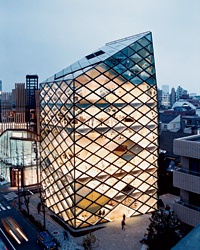 Dean Kaufman Herzog & de Meuron's Prada flagship on Omotesando Street, Tokyo.
On a single street in Tokyo—Omotesando—the world's elite luxury brands have built one dazzling flagship store after another. Luke Barr takes a look at fashion's new architecture.
Dean Kaufman Herzog & de Meuron's Prada flagship on Omotesando Street, Tokyo.
On a single street in Tokyo—Omotesando—the world's elite luxury brands have built one dazzling flagship store after another. Luke Barr takes a look at fashion's new architecture.
Saturday morning on Omotesando, and the broad sidewalks are crowded, but not overly so, buzzing with early-weekend optimism and the anticipation of shopping yet to be done. Beneath the shady trees lining this central Tokyo boulevard, the pace is leisurely, with an ambling crowd of young couples, small families, posses of teenagers, middle-aged men and women in suits, leather-jacketed dyed-blond hipsters on Vespas, and outlandish Goth kids trickling in from nearby Harajuku. Most of all, it's a parade of casual designer chic: the women's shoes are pointy and colorful, every handbag is a fashion statement.
Outside Omotesando Hills, a great slab of a shopping mall that opened this past February (replacing the beloved 1920's Dojunkai apartments), shoppers gather while a security guard checks his watch. The doors open at 11:05 a.m. exactly.
The building was designed by Tadao Ando, Japan's preeminent architect, and it's done in his typically minimalist style, gleaming discreetly despite its vast scale—the mall stretches for two blocks and contains dozens of shops, including Yves Saint Laurent, Theory, and Dolce & Gabbana. It's shopping that has drawn the crowd (by the time the doors open, hundreds of people are waiting to get in), but it's the architecture—the imprimatur of serious design—that has made this place a destination.
The same might be said of Omotesando as a whole: just across the street is the Dior shop designed by Kazuyo Sejima and Ryue Nishizawa of SANAA, the much-admired team whose building for the New Museum of Contemporary Art, in New York City, is currently under construction. Also opposite the new Ando building is the Jun Aoki-designed Louis Vuitton flagship, and just down the street are Toyo Ito's Tod's store, Kengo Kuma's One Omotesando, which houses Fendi, Donna Karan, and Celine, and Herzog & de Meuron's jewel-like Prada store.
These buildings (all of which have gone up during the past five or so years) are monuments to Japan's sophisticated, hyperactive consumerism—and to the striving ambitions of global branding. After all, what are they if not five-story, three- dimensional billboards, glittering, abstract, and seductive?
It was LVMH that pioneered this approach in Tokyo. The luxury conglomerate decided to commission "epoch-making architecture," says Kuma, whose subtle, wood-clad structure was completed in 2003, and it made a point of working with younger, up-and-coming architects. "They wanted more than just 'fashion buildings,' " he says. "They wanted a true fusion of fashion and architecture." Eric Carlson, until recently the co-head of design for Louis Vuitton, and the person perhaps most intimately responsible for this latest iteration of the high-design fashion flagship, sees the buildings as "another way to communicate with very discerning shoppers," and says they mark the welcome end of "cookie-cutter retail design." Carlson's Paris-based firm, Carbondale, designed the Louis Vuitton store on the Champs-Élysées, which opened last year and includes light installations by James Turrell and an art gallery.
All this rather theatrical design serves a purpose: "Shopping has invaded every domain, every aspect of life," says Ole Scheeren, a partner at OMA and the lead designer of the seminal Prada stores in New York and L.A. "And so the luxury experience has to be about more than just shopping." In Omotesando, that's already the case.